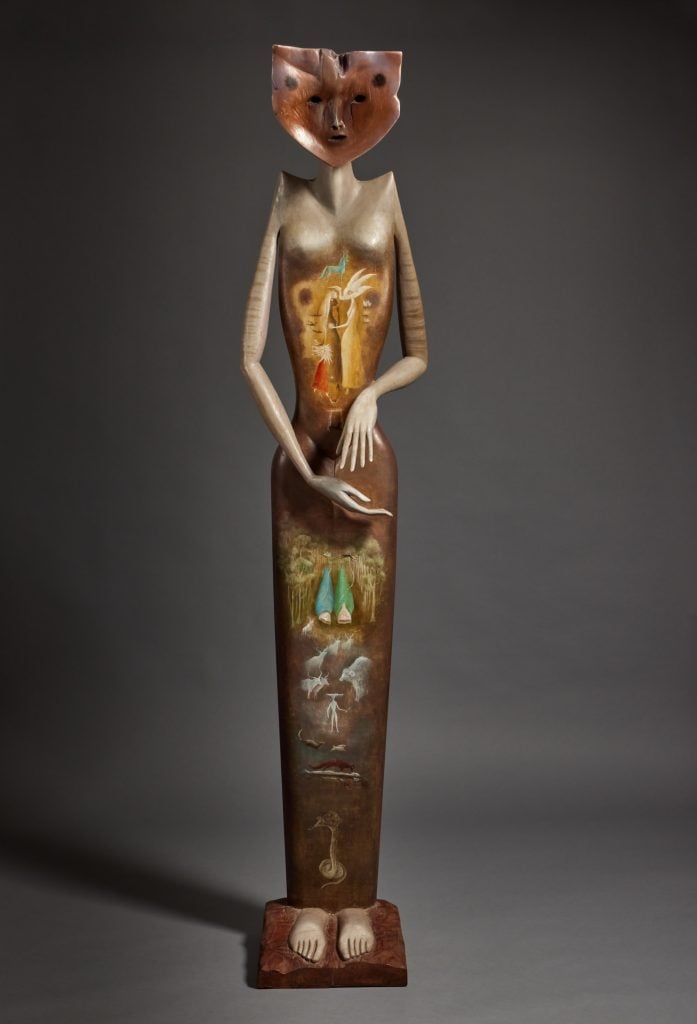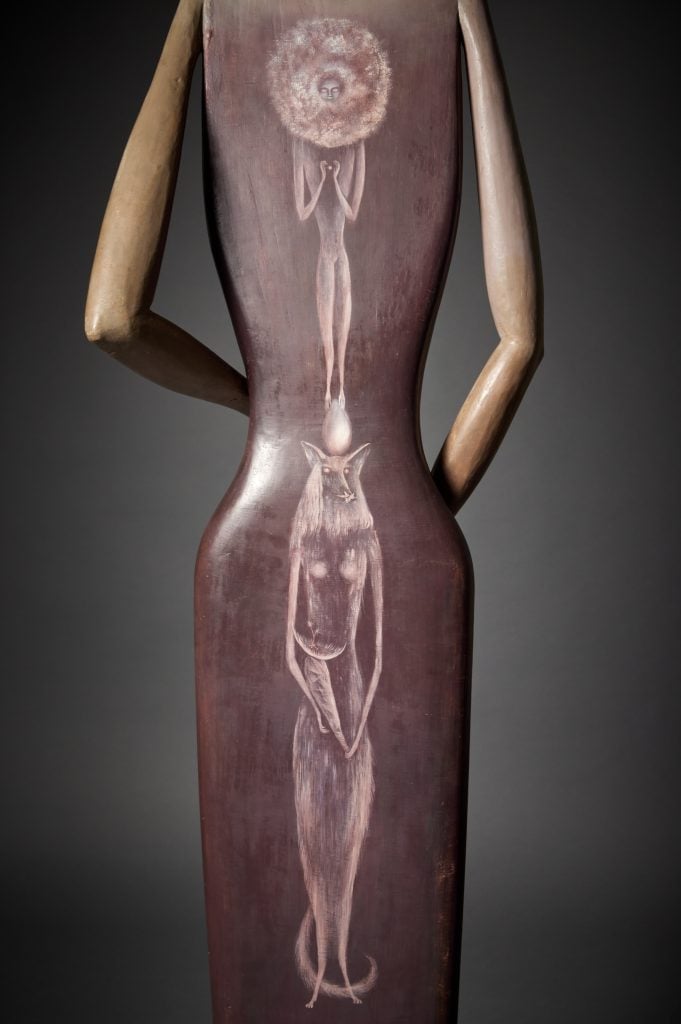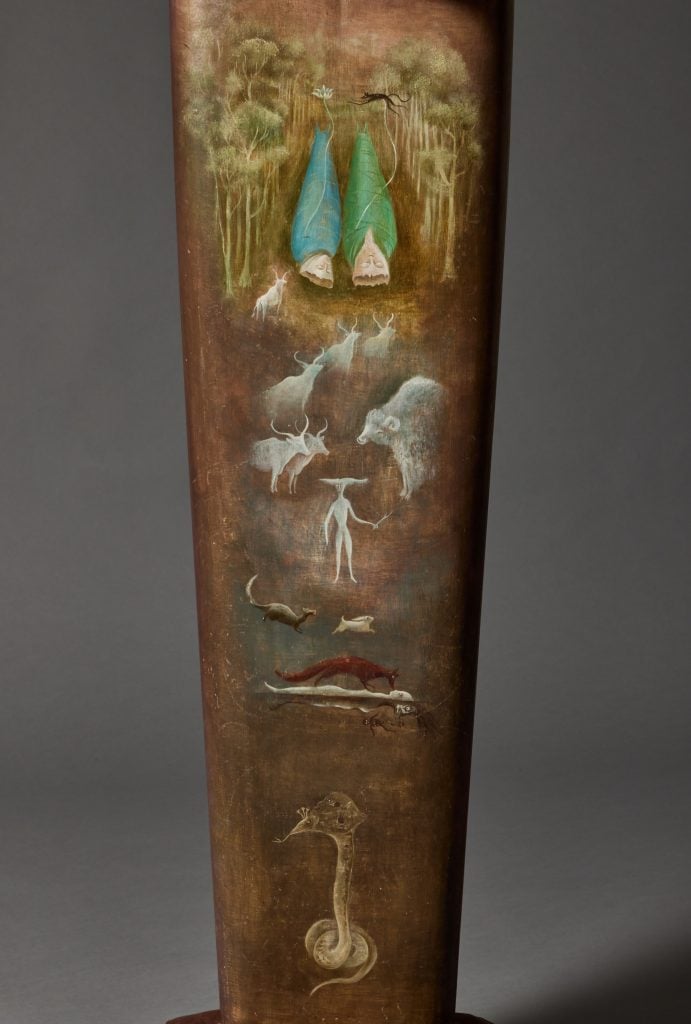Auctions
Leonora Carrington’s ‘Otherworldly’ Cat Woman Sculpture Sells for a Record $11.4 Million
The sculpture was once in the collection of Surrealist patron Edward James.

A towering sculpture by Leonora Carrington sold at Sotheby’s New York last night for $11.4 million, making it the most valuable sculpture by the Surrealist ever sold at auction. Titled La Grande Dame (The Cat Woman), it blew by its estimate of $5 million to $7 million and has become the second highest price ever achieved for the artist at auction.
The sculpture’s arrival at Sotheby’s represents a continuation of the surging interest in the work of the British-Mexican artist. Five bidders battled it out for the work over five minutes before the hammer fell to leading collector and champion of Latin American art Eduardo Costantini, bidding on the phone via Sotheby’s Head of Latin American Art, Anna Di Stasi.
Costantini was also the buyer of Les Distractions de Dagobert, which sold for a record-setting $28.5 million at Sotheby’s New York in May. Back in 1995, the same work went for $475,500 ($990,000, adjusted for inflation).
“Leonora Carrington has long been, in my view, one of the greatest exponents of the Surrealist movement,” Julian Dawes, Sotheby’s Head of Impressionist and Modern art said, adding that La Grande Dame is the best of Carrington’s sculptures. “We were all thrilled to see its quality recognized by so many determined bidders tonight, and to know that the sculpture will now sit alongside the record-breaking Les Distractions de Dagobert.”
Created in 1951, almost a decade on from her relocation to Mexico, the carved wooden sculpture stems from a period of febrile creativity during which Carrington fell in with a clique of artists who shared her fascination with spiritualism and the occult. Standing well over six feet tall, La Grande Dame is a poised, puzzling figure with elongated features and an indecipherable expression spread across its spade-shaped head.
It was one of several works made in collaboration with the woodworker José Horna (husband of her friend Kati Horna, the surrealist photographer) with Carrington spreading her Hieronymus Bosch-like figures across its body. The scenes present Carrington’s characteristic concerns of femininity and the cycles of life and deploy symbolism from Ancient Egyptian, Celtic, and Mexican mythology.

Leonora Carrington, La Grande Dame (1951). Photo: Sotheby’s.
“The work synthesizes diverse iconographies of the divine feminine into a human dimension,” said Di Stasi, Sotheby’s head of Latin American Art. “La Grande Dame creates a profound sense of otherworldly presence acting as a Surrealist portal to transport the viewer both physically and psychically into her wondrous universe.”
On the sculpture’s chest, this universe sees a teal-colored unicorn presiding over a scene in which a gleaming egg is handed from one woman to another, a girl in red waits below, her palm open. The egg, a frequent Carrington symbol of female power and potential, reappears on the La Grande Dame’s back hovering between a dandelion figure and a wolf-like goddess.

Reverse of Leonora Carrington, La Grande Dame (1951). Photo: Sotheby’s.
Following Carrington’s death in 2011, the Surrealist has belatedly received museum retrospectives across the U.K., Spain, and Denmark. La Grande Dame, which had long been in the collection of Surrealist patron Edward James, has itself been exhibited at venues from the Tate Modern in London to the Metropolitan Museum of Art in New York.

Detail of Leonora Carrington, La Grande Dame (1951). Photo: Sotheby’s.
Amid rising market interest, there has been a heated debate among experts and family members over the authenticity of Carrington’s late bronze sculptures according to a recent report by The Art Newspaper. From 2008 through to her death, Carrington continued to make art, but was unable to paint on account of arthritis. Work from this period has duly come under suspicion.
On the one side, Consejo Leonora Carrington, represented by her younger son, Pablo Weisz Carrington, issues certificates of authenticity for dozens of bronzes from this period. It considers them an exclusive group whose creation was entirely overseen by the artist. On the other side, Gabriel Weisz Carrington, the elder son, who runs the Fundación Leonora Carrington believes the bronzes are the work of profiteering foundries. A surreal turn, to be sure.
This article was updated on November 19, 2024.





